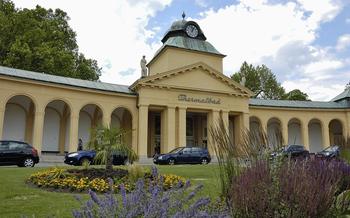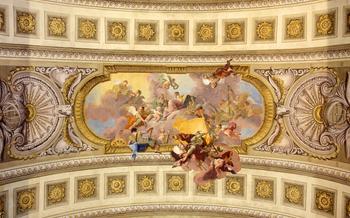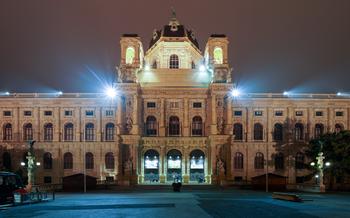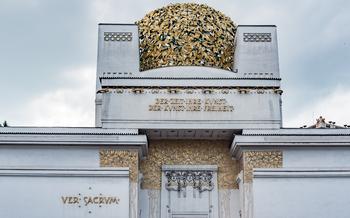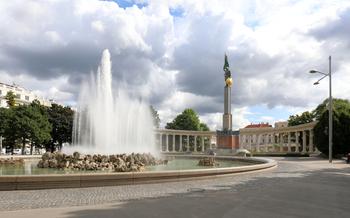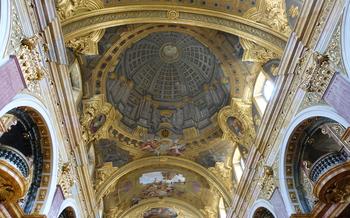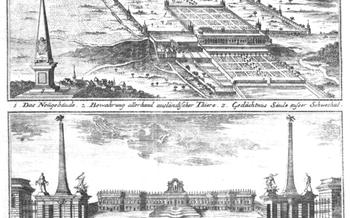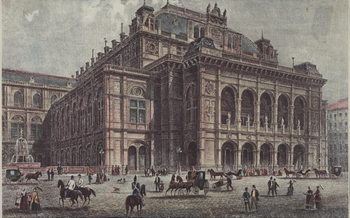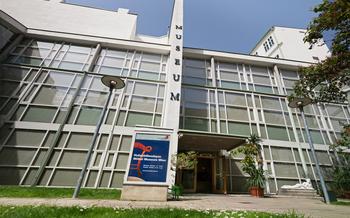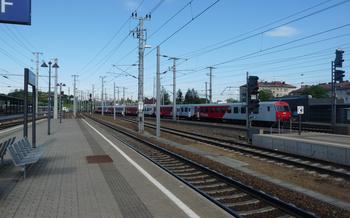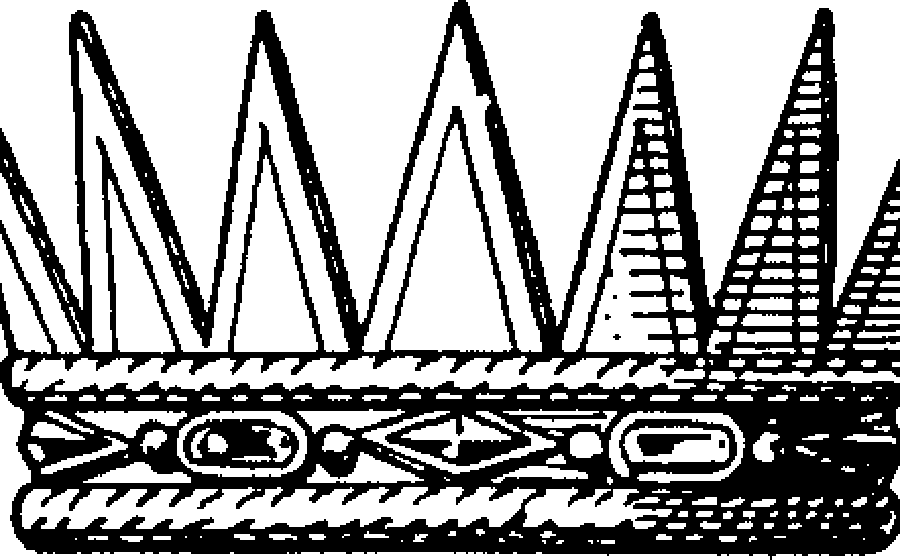
Austrian National Library
- Architectural Marvel
- Literary Treasures
- Reading Rooms and Study Spaces
- Guided Tours
- Educational Programs
- Digital Collections
- Special Events
- Accessibility
- Visitor Information
- Dress Code
- Photography and Filming
Architectural Marvel
The Austrian National Library stands as a testament to the grandeur and opulence of Baroque architecture. Its awe-inspiring facade, adorned with intricate carvings and sculptures, sets the tone for a journey through the realms of knowledge and literary heritage. Step inside, and you'll be greeted by a majestic staircase, its graceful curves leading you to the upper floors. The reading rooms, with their soaring ceilings and ornate chandeliers, create an atmosphere of scholarly reverence. Every corner of the library is adorned with decorative elements, from the intricate ceiling frescoes to the finely crafted sculptures that adorn the walls. The harmonious blend of architecture and art creates a truly immersive experience, transporting visitors back to a time when knowledge was revered and celebrated.
Literary Treasures
The Austrian National Library houses over 12 million books and manuscripts, making it one of the largest and most comprehensive libraries in the world. Among its many treasures are the Papyrus Erzherzog Rainer, a collection of ancient Egyptian papyri dating back to the 3rd century BC, and the Codex Vindobonensis, a 6th-century manuscript of the Gospels. The library also possesses a vast collection of medieval manuscripts, incunabula (books printed before 1501), and rare books.
The library's collection is particularly strong in the fields of Austrian history, literature, and music. It houses the works of many famous Austrian authors, including Peter Handke, Elfriede Jelinek, and Thomas Bernhard. The library also has a large collection of musical scores and manuscripts, including works by Mozart, Haydn, and Beethoven.
The Austrian National Library is committed to preserving and digitizing its rare and valuable works. Through its digitization program, the library is making its collection accessible to researchers and scholars around the world. The library's digital collections include books, manuscripts, maps, and other resources that can be accessed online.
Reading Rooms and Study Spaces
The Austrian National Library boasts a network of tranquil and well-equipped reading rooms that cater to the needs of researchers, scholars, and students. These spaces offer a serene environment conducive to focused study and research. The Main Reading Room, located in the heart of the library, is a particularly awe-inspiring space with its vaulted ceilings, ornate chandeliers, and rows of wooden desks. Specialized study areas are also available for those pursuing research in specific subjects or disciplines, such as law, history, and music.
The library's extensive collection of books and manuscripts is complemented by a wealth of digital resources, databases, and online catalogs. These resources can be accessed from the library's computer terminals or via remote access for registered users. The library staff is always on hand to assist visitors with their research needs and to provide guidance on using the library's resources effectively.
Guided Tours
The Austrian National Library offers a range of guided tours tailored to diverse interests and knowledge levels. General tours provide an overview of the library's history, architecture, and collections. Thematic tours delve into specific subjects, such as the history of printing or the treasures of the music collection. For a more immersive experience, visitors can opt for behind-the-scenes tours, which offer a glimpse into the library's inner workings, including the conservation studios and rare book storage facilities.
The tours are led by knowledgeable and enthusiastic guides who bring the library's stories to life. They share fascinating anecdotes about the collection's highlights and shed light on the library's role in preserving and disseminating knowledge. Tours are conducted in various languages, including English, German, French, Italian, and Spanish, ensuring accessibility to visitors from around the world.
Educational Programs
The Austrian National Library offers a comprehensive range of educational programs and workshops designed to engage and inspire students, researchers, and the general public. These programs aim to promote knowledge, understanding, and appreciation of the library's vast collection and rich cultural heritage.
One of the highlights of the educational program is the "Paleography Workshop," which introduces participants to the art of reading and interpreting ancient and medieval manuscripts. Participants learn about different writing systems, scripts, and abbreviations, gaining valuable insights into the historical context and significance of these documents.
Another popular program is the "Bibliography Workshop," which equips participants with the skills to conduct effective research using the library's extensive resources. Participants learn how to navigate the library's catalogs, databases, and online resources, as well as how to properly cite and reference sources in their research.
For those interested in the art of bookbinding, the library offers a "Bookbinding Workshop," where participants can learn the traditional techniques of bookbinding and create their own handmade books. The workshop covers everything from selecting the right materials to sewing and assembling the book, providing a hands-on experience of this ancient craft.
In addition to these workshops, the library also organizes lectures, seminars, and conferences on various topics related to its collection and research activities. These events provide a platform for scholars, experts, and the public to engage in discussions, share knowledge, and explore new perspectives.
The educational programs at the Austrian National Library offer a unique opportunity to delve deeper into the world of books, manuscripts, and cultural heritage. Whether you are a student, researcher, or simply someone with a passion for learning, these programs provide a valuable and enriching experience.
Digital Collections
The Austrian National Library has made vast strides in digitizing its extensive collections, making them accessible to scholars, researchers, and the general public worldwide. Its digital collections encompass a diverse range of materials, including books, manuscripts, maps, photographs, and other resources. These digitized treasures can be conveniently accessed through the library's user-friendly website, providing a wealth of knowledge and information at your fingertips.
The digital collections offer a unique opportunity to explore rare and valuable works that may not be easily accessible in physical form. Whether you are a student researching a particular topic, a scholar seeking primary sources, or simply someone with a passion for history and culture, the library's digital archives provide a treasure trove of resources to delve into.
The library's commitment to digitization ensures the preservation and accessibility of its vast heritage for generations to come. It also facilitates global collaboration and research, allowing scholars from around the world to access and study rare materials without the need for physical travel.
To access the digital collections, simply visit the Austrian National Library's website, where you will find a comprehensive search interface and user-friendly navigation tools. Whether you are looking for a specific item or browsing through the vast collection, the digital archives offer a wealth of discoveries waiting to be explored.
Special Events
The Austrian National Library hosts a variety of special events, lectures, and conferences throughout the year that offer visitors the opportunity to engage with authors, scholars, and experts in various fields. These events provide a platform for lively discussions, insights into current research, and the exchange of ideas.
Book launches, author readings, and panel discussions are regular highlights of the library's calendar. Visitors can meet renowned authors, listen to their readings, and participate in Q&A sessions, gaining firsthand insights into the creative process and the minds behind their favorite stories.
Conferences and symposia on diverse topics, ranging from history and literature to art and music, bring together experts from around the world to share their knowledge and research findings. These events offer attendees the chance to learn from leading scholars, network with peers, and contribute to the advancement of knowledge in their respective fields.
Special exhibitions, often accompanied by lectures and workshops, showcase the library's unique collections and delve into specific themes or historical periods. These exhibitions provide visitors with an immersive experience, allowing them to explore rare and valuable artifacts up close and gain a deeper understanding of their significance.
Whether you're a literature enthusiast, a history buff, or simply curious about the world of books and knowledge, the Austrian National Library's special events offer something for everyone. Check the library's website or social media channels for upcoming events and join the vibrant community of readers, scholars, and culture enthusiasts.
Accessibility
The Austrian National Library is committed to ensuring that all visitors, regardless of their abilities, have an enjoyable and accessible experience. The library features several accessibility features to accommodate visitors with disabilities.
Wheelchair-accessible entrances, elevators, and adapted restrooms are available throughout the building, allowing visitors to navigate the library with ease. Assistive devices and services are also provided for visually and hearing-impaired visitors, including magnifiers, headsets, and sign language interpreters upon request. The library staff is dedicated to assisting visitors with disabilities and making their visit as comfortable and inclusive as possible.
Visitor Information
The Austrian National Library is conveniently located in the heart of Vienna, making it easily accessible to visitors.
The exact address is Josefsplatz 1, 1015 Vienna, Austria. For any inquiries, visitors can contact the library via phone at +43 1 53410 or send an email to [email protected]. Additionally, the library's official website, www.onb.ac.at, provides comprehensive information about its collections, exhibitions, events, and services.
The library's operating hours are Tuesday to Sunday from 10 am to 6 pm. It remains closed on Mondays and public holidays. Visitors are advised to check the website for any temporary closures or special events that may affect the regular opening hours.
Getting to the library is a breeze, with excellent public transportation connections nearby. The nearest metro station is Herrengasse (U3 line), and several bus lines (1A, 2A, and 3A) stop close to the library. For those arriving by car, there are several parking garages in the vicinity, such as the Am Hof garage and the Freyung garage.
To ensure a smooth and enjoyable visit, remember to dress appropriately, adhering to the library's formal and scholarly atmosphere. Maintaining silence and refraining from disruptive behavior while in the reading rooms is essential to respect the studious environment.
Dress Code
When visiting the Austrian National Library, it is essential to dress appropriately, respecting its formal and scholarly atmosphere. Visitors are expected to maintain a professional and respectful appearance throughout their visit. This means avoiding casual or revealing clothing, such as shorts, tank tops, or flip-flops. Instead, opt for smart casual or business attire.
Additionally, visitors are required to maintain silence and refrain from disruptive behavior while in the reading rooms. This is to ensure a peaceful and conducive environment for research and study. Please be mindful of other visitors and keep your voice low, turn off your mobile phone, and avoid engaging in loud conversations or activities that may disturb others.
Photography and Filming
The Austrian National Library welcomes photography and filming for personal, non-commercial purposes, allowing visitors to capture their memories and share their experiences. However, to maintain the tranquility and preservation of the library's collections, certain guidelines must be followed. Photography is permitted in most public areas, including the grand entrance hall, the staircases, and the reading rooms, as long as it does not disturb other visitors or disrupt the library's operations. The use of flash or tripods is prohibited to minimize damage to the delicate materials and artifacts. For commercial photography or filming, prior permission must be obtained from the library's administration. The library staff is happy to assist visitors in selecting suitable locations and ensuring that their activities comply with the library's policies.
